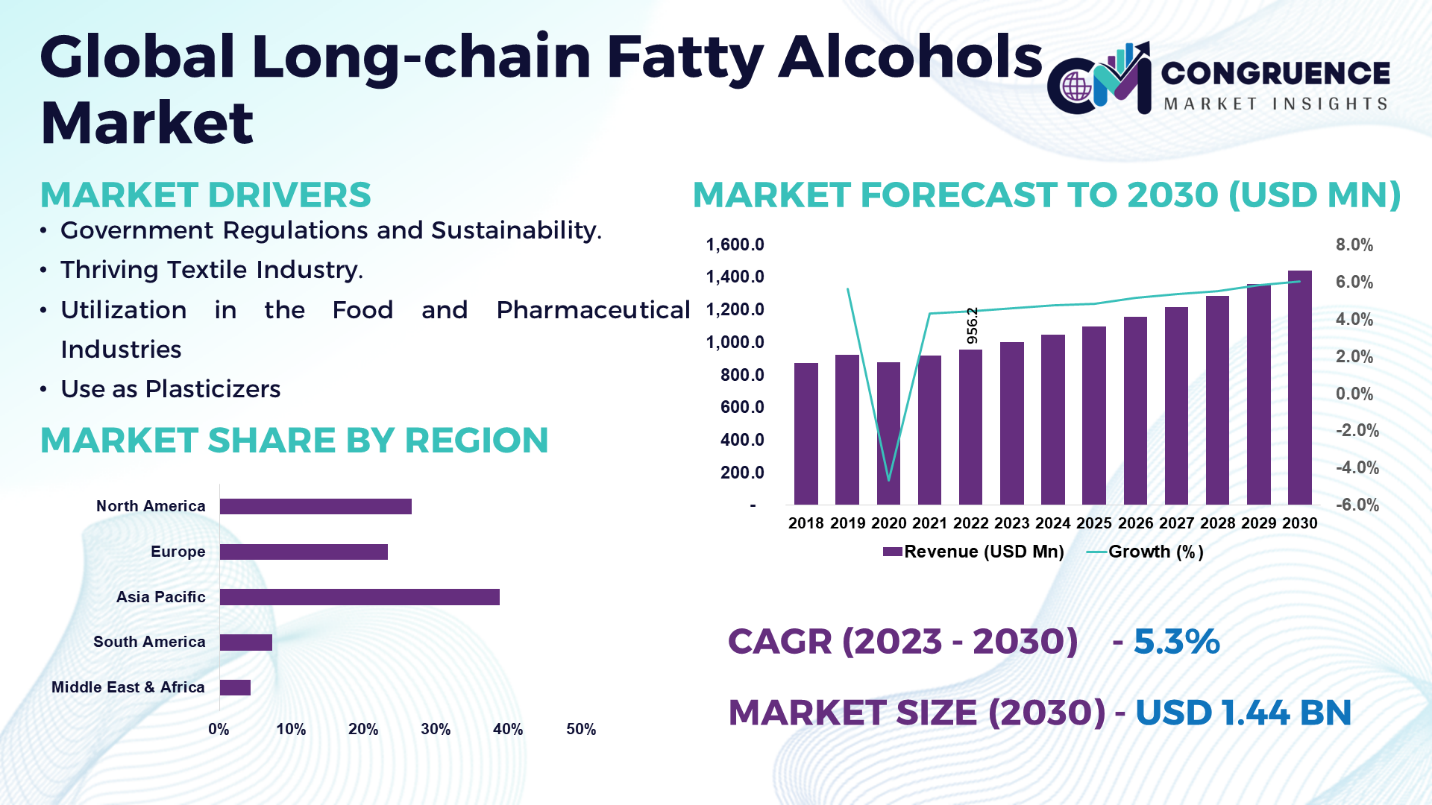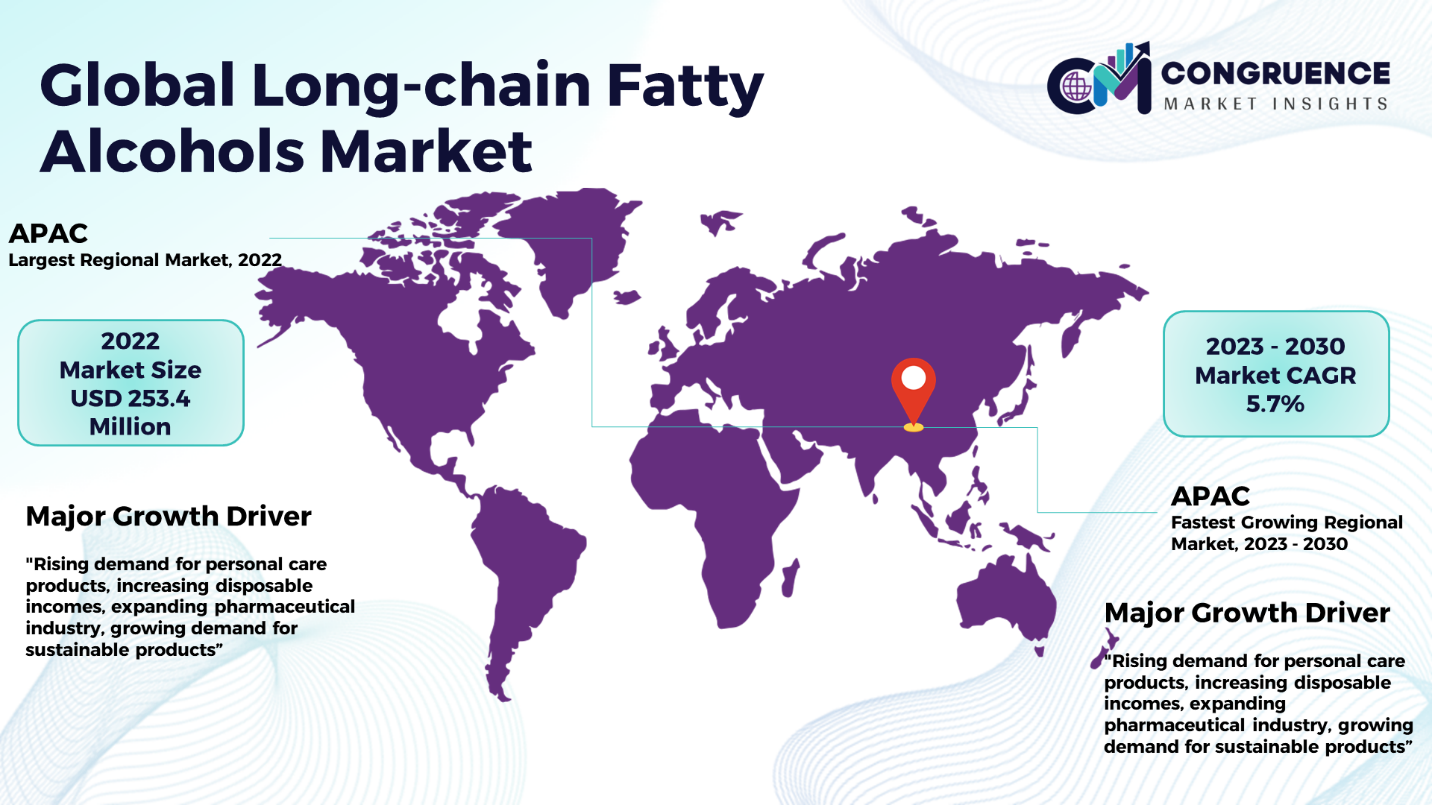Reports
The Global Long-Chain Fatty Alcohols Market was valued at USD 956.2 Million in 2022 and is anticipated to reach a value of USD 1,438.2 Million by 2030 expanding at a CAGR of 5.3% between 2023 and 2030.
Long-chain fatty alcohols are high-molecular-weight alcohols derived from oils and fats containing three to seventy-seven carbon atoms. These may consist of waxy substances, colorless sticky fluids (for lower carbon numbers), or saturated or unsaturated liquids. Fatty alcohols can come from petrochemical or biological sources. Since these substances are amphipathic, fatty alcohols are used to create non-ionic surfactants and detergents. Fatty alcohols find application in pulp and paper, cosmetics, solubilizers, emollients, thickeners, and other sectors. Alcohol surfactants serve as lipophilic solubilizers in pharmaceutical lotions. Global increase in hygiene product demand coupled with increasing consumer awareness is expected to drive the personal care industry and fuel the growth of the fatty alcohol market. Growing octadecenol, oleyl alcohol, echolocation, natural emulsifiers, and surfactant demand in the soaps and detergents industry is anticipated to boost demand for fatty alcohols. Fatty alcohols are also used in plasticizers which in turn are used in plastics for improving physical-mechanical properties.

Long-Chain Fatty Alcohols Market Major Driving Forces
Government Regulations and Sustainability: Globally, regulations and guidelines are being introduced by governments and regulatory authorities to encourage environmentally friendly activities and lessen their effect on our natural surroundings. The usage of eco-friendly ingredients and renewable resources is encouraged by these standards. Since these products has organic origin, fatty alcohols support such sustainability objectives. A conducive atmosphere is created for the fatty alcohol market's expansion by this regulatory backing.
Thriving Textile Industry: Fatty alcohols are utilized in the production of fatty alcohol ethoxylates, which are employed in the textile sector for scouring and emulsifying purposes. They serve as wetting agents and in dye leveling as well. Global demand for fatty alcohol may rise as a result of the booming textile sector.
Utilization in the Food and Pharmaceutical Industries: Numerous pharmaceutical and food applications involve the consumption of long chain fatty alcohols. They have emollient, solvent, and lubricant uses in the pharmaceutical industry. These are employed as antifoaming agents, stabilizers, and emulsifiers in the food industry. It is anticipated that the growing uses of long chain fatty alcohols in these sectors will propel market expansion.
Use as Plasticizers: In order to enhance the physical-mechanical characteristics and processing capability of plastic and its co-polymer compositions, fatty alcohols containing glycerol fatty esters are utilized as plasticizers. The demand for fatty alcohols increases when plasticizer is used extensively to increase a material's general flexibility thus making it bendable.
Long-Chain Fatty Alcohols Market Key Opportunities
Increasing Awareness Regarding Bio-Products: The growing consumer recognition of the advantages of bio-based products due to the toxicity of petrochemical-based alternatives is expected to push people toward using natural products. It follows that there should be plenty of room for expansion in the years to come.
Integration of Artificial Intelligence: Artificial Intelligence has the potential to enhance the production processes of fatty alcohols. Artificial intelligence (AI) algorithms can analyze massive volumes of information from production lines to find trends, spot ineffectiveness, and recommend changes that will increase output, cut down on waste, and maximize resource use.
Extension into New Markets: There are a plethora of possible markets for long-chain fatty alcohols, including food, textiles, and pharmaceuticals. In order to expand their customer base and boost revenue, enterprises may investigate such uncharted marketplaces.
Long-Chain Fatty Alcohols Market Key Trends
· In order to produce detergents and surfactants, fatty alcohols are mostly utilized. Since they are amphipathic, fatty alcohols function similar to nonionic surfactants.
· The vast majority of fatty alcohols in the world are transformed into surface active agents, also known as surfactants, which are the building blocks needed to make dishwashing and laundry detergents as well as additional home maintenance supplies.
· The favorable conditions of the market have been facilitated by the growing consumer preference for sustainable products, the growth of the personal care and cosmetics industry, and the expanding applications in the chemical and pharmaceutical sectors.
· Within the global fatty alcohol market, the cleaning application segment for domestic and industrial use is regarded as one of the largest. Owing to their many qualities, fatty alcohols—which come from natural fats and oils—are beneficial in cleaning products.
Region-wise Market Insights
Asia Pacific accounted for the largest market share at 38.7% in 2022 moreover, Asia Pacific is expected to register the fastest growth, expanding at a CAGR of 5.7% between 2023 and 2030.

The market for fatty alcohol is expanding rapidly in the Asia Pacific area. It is the primary driver of market growth owing to growing interest from the surfactant and personal care & cosmetics sectors. The market would grow rapidly as a result of rising disposable incomes in China, India, and South Korea. Furthermore, there are indications of increased usage coming from China, which is home to several of the biggest manufacturers of soap and detergent worldwide. The demand for fatty alcohols is rising in the region due to its rapid economic growth and government regulations aimed at reducing their harmful effects on the environment, particularly in China and India. With regard to the expansion of the personal care and cosmetics sectors, APAC, a significant producer and consumer of fatty alcohols, is expected to hold its current market share. The growing need for surfactants is connected to the market expansion in North America. In addition to increasing demand for sanitizers and household cleaning supplies in this area, the COVID-19 outbreak would also promote their use. The European market is unique due to the personal care industry's explosive demand.
Market Competition Landscape
There is fierce competition among many manufacturers in the global market for long chain fatty alcohols. In order to obtain a competitive advantage, major players in the long chain fatty alcohols market employ certain strategies. These tactics involve coming up with new products and using sustainable and environmentally friendly substances to cater to changing customer preferences. Leading companies rely on their quality and dependability reputation to hold onto market share, while more recent competitors concentrate on novel approaches and USPs. The different needs of consumers in different regions also contribute to market competition.
Prominent entities in the worldwide market for long chain fatty alcohols employ diverse organic and inorganic tactics to fortify and enhance their market standing. Prominent players in the market include:
· Wilmar International Ltd.
· Kao Corporation
· Kuala Lumpur Kepong Berhad
· Musim Mas Holdings
· Godrej Industries Limited
· Procter & Gamble
· VVF L.L.C.
· Sasol
· Emery Oleo Chemicals
· Royal Dutch Shell Plc
· Berg+Schmidt GmbH & Co. KG
· Oxiteno S.A. Indústria e Comércio
· Zhejiang Jiahuam
· Zhejiang Heng Xiang Chemical
· Teck Guan
· Sinarmas Cepsa Pte. Ltd.
· P & G Chemicals
An international company based in India, Godrej Industries Limited is active in the fatty alcohols sector. Both natural and synthetic long chain fatty alcohols are produced by the company. One of the main suppliers to the detergent and personal care industries is Godrej Industries Limited. With a significant foothold in Asia Pacific, the Singapore-based Wilmar International Ltd. is one of the top producers of fatty alcohols worldwide. Long-chain fatty alcohols, both natural and synthetic, are part of the company's diverse product line. Food, personal care, pharmaceuticals, and industrial applications are just a few of the industries to which Wilmar International Ltd. is a significant supplier.
|
Report Attribute/Metric |
Details |
|
Market Revenue in 2022 |
USD 956.2 Million |
|
Market Revenue in 2030 |
USD 1,438.2 Million |
|
CAGR (2023 – 2030) |
5.3% |
|
Base Year |
2022 |
|
Forecast Period |
2023 – 2030 |
|
Historical Data |
2018 to 2022 |
|
Forecast Unit |
Value (US$ Mn) |
|
Key Report Deliverable |
Revenue Forecast, Growth Trends, Market Dynamics, Segmental Overview, Regional and Country-wise Analysis, Competition Landscape |
|
Segments Covered |
· By Type (Natural Sources And Petrochemical Sources) · By Application (Surfactants, Pharmaceuticals, Lubricants, Personal Care, Foods, And Other Applications) · By End-User (Consumers, Industrial Users, And Institutional Users) |
|
Geographies Covered |
North America: U.S., Canada and Mexico Europe: Germany, France, U.K., Italy, Spain, and Rest of Europe Asia Pacific: China, India, Japan, South Korea, Southeast Asia, and Rest of Asia Pacific South America: Brazil, Argentina, and Rest of Latin America Middle East & Africa: GCC Countries, South Africa, and Rest of Middle East & Africa |
|
Key Players Analyzed |
Wilmar International Ltd., Kao Corporation, Kuala Lumpur Kepong Berhad, Musim Mas Holdings, Godrej Industries Limited, Procter & Gamble, VVF L.L.C., Sasol, Emery Oleo Chemicals, Royal Dutch Shell Plc., Berg+Schmidt GmbH & Co. KG, Oxiteno S.A. Indústria e Comércio, Zhejiang Jiahuam, Zhejiang Heng Xiang Chemical, Teck Guan, Sinarmas Cepsa Pte. Ltd., P & G Chemicals |
|
Customization & Pricing |
Available on Request (10% Customization is Free) |
